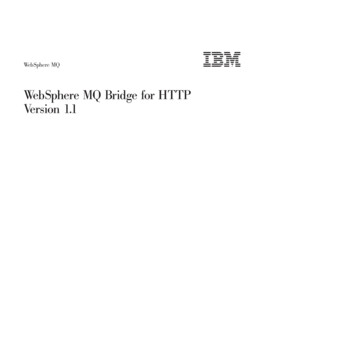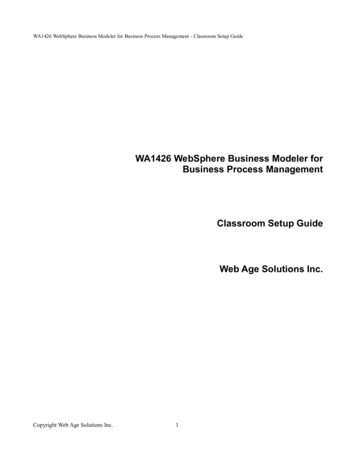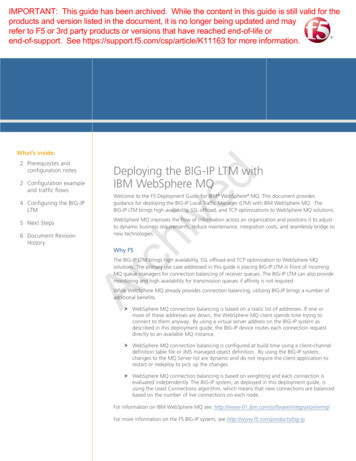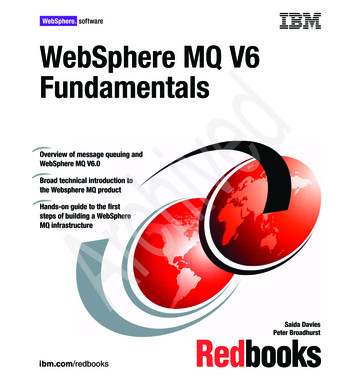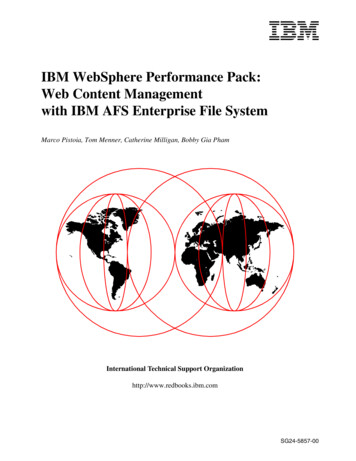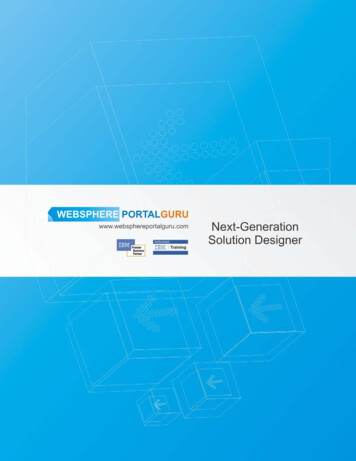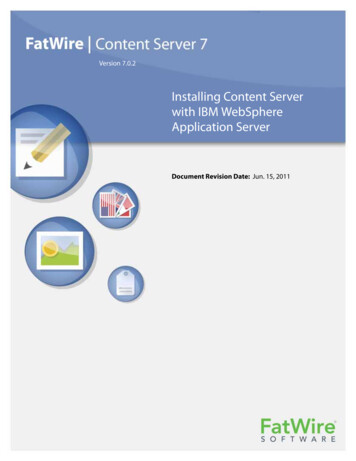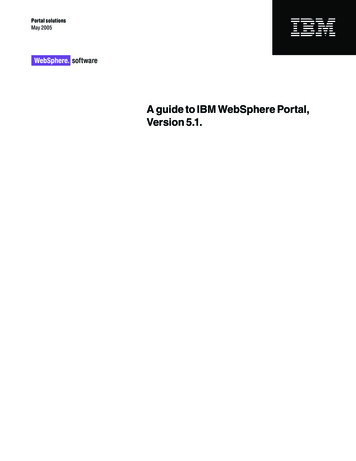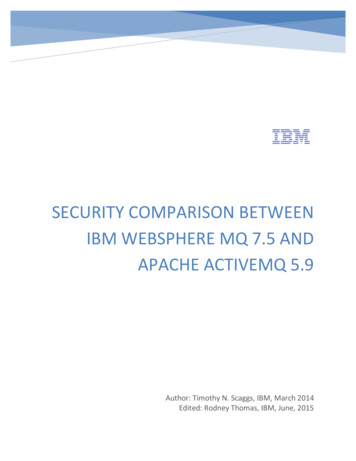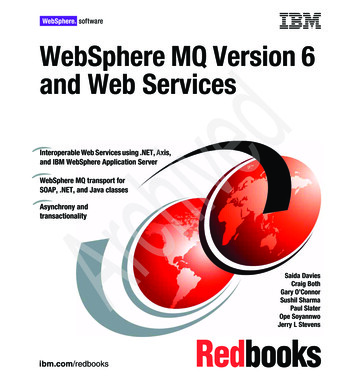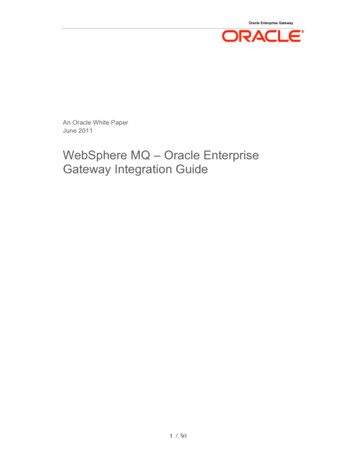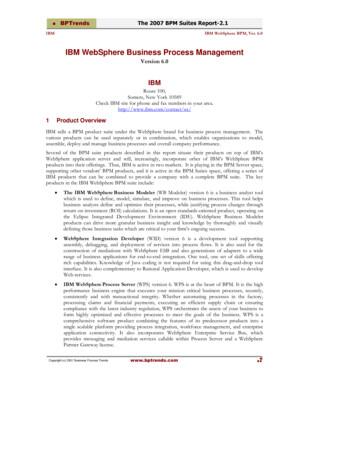
Transcription
IBMIBM WebSphere BPM, Ver. 6.0IBM WebSphere Business Process ManagementVersion 6.0IBMRoute 100,Somers, New York 10589Check IBM site for phone and fax numbers in your area.http://www.ibm.com/contact/us/1Product OverviewIBM sells a BPM product suite under the WebSphere brand for business process management. Thevarious products can be used separately or in combination, which enables organizations to model,assemble, deploy and manage business processes and overall company performance.Several of the BPM suite products described in this report situate their products on top of IBM’sWebSphere application server and will, increasingly, incorporate other of IBM’s WebSphere BPMproducts into their offerings. Thus, IBM is active in two markets. It is playing in the BPM Server space,supporting other vendors’ BPM products, and it is active in the BPM Suites space, offering a series ofIBM products that can be combined to provide a company with a complete BPM suite. The keyproducts in the IBM WebSphere BPM suite include: The IBM WebSphere Business Modeler (WB Modeler) version 6 is a business analyst toolwhich is used to define, model, simulate, and improve on business processes. This tool helpsbusiness analysts define and optimize their processes, while justifying process changes throughreturn on investment (ROI) calculations. It is an open standards-oriented product, operating onthe Eclipse Integrated Development Environment (IDE). WebSphere Business Modelerproducts can drive more granular business insight and knowledge by thoroughly and visuallydefining those business tasks which are critical to your firm’s ongoing success. WebSphere Integration Developer (WID) version 6 is a development tool supportingassembly, debugging, and deployment of services into process flows. It is also used for theconstruction of mediations with WebSphere ESB and also generations of adapters to a widerange of business applications for end-to-end integration. One tool, one set of skills offeringrich capabilities. Knowledge of Java coding is not required for using this drag-and-drop toolinterface. It is also complementary to Rational Application Developer, which is used to developWeb services. IBM WebSphere Process Server (WPS) version 6. WPS is at the heart of BPM. It is the highperformance business engine that executes your mission critical business processes, securely,consistently and with transactional integrity. Whether automating processes in the factory,processing claims and financial payments, executing an efficient supply chain or ensuringcompliance with the latest industry regulation, WPS orchestrates the assets of your business toform highly optimized and effective processes to meet the goals of the business. WPS is acomprehensive software product combining the features of its predecessor products into asingle scalable platform providing process integration, workforce management, and enterpriseapplication connectivity. It also incorporates WebSphere Enterprise Service Bus, whichprovides messaging and mediation services callable within Process Server and a WebSpherePartner Gateway license.1
IBMIBM WebSphere BPM, Ver. 6.0 IBM WebSphere Business Monitor (WB Monitor) version 6.0 is a real-time monitor thatutilizes visual dashboards to provide a dynamic view of business processes for improvedbusiness decision-making. This tool gives you the window into your business processperformance. It enables you to monitor business processes in real-time, providing a visualdisplay of business process status. Alerts and notifications sent to key users facilitatecontinuous improvement of your business processes. The customizable dashboardimplemented as WebSphere Portal pages are visually intuitive, featuring scorecards, keyperformance indicators, and gauges. WebSphere Partner Gateway serves as a connector between global trading partners and otherbusinesses via electronic data interchange (EDI). It enables business communications bytransforming data between ROD, XML and EDI formats. WebSphere Adapters discover information and processes held within business andapplications and expose them as a set of reusable services. Adapters coordinate inbound andoutbound flows of information between applications and the service requester. With a widerange of pre-built adapters for ERP (SAP), HR (PeopleSoft/Oracle), CRM (Seibel), supplychain systems, and many other applications, customers can drastically accelerate their “time tovalue.”(As mentioned previously many of the capabilities found in earlier products such as WebSphere MQWorkflow (formerly MQ Series Workflow), WebSphere Server Foundation, and WebSphere InterchangeServer are now embedded in WebSphere Process Server, and have been available for years. Others havebeen redesigned to function within a BPM environment, and still others are essentially new productsdeveloped for the BPM market. More important, IBM is defining an infrastructure that will tie all of itsBPM offerings together. Simultaneously, it is working with others to create BPM standards (e.g., BPEL,etc.) to assure that IBM customers’ and partners’ BPM solutions will integrate with IBM’s and othervendors’ BPM products. Existing BPM Suites, to the degree that they define their internal infrastructureand interfaces, do so only in a causal way, since they really are not designed as a set of BPM componentsthat a client might pick and choose. IBM has consciously designed a BPM environment with open, welldefined programming interfaces and standards so that companies and partners can deploy a BPM Suitethat addresses their specific needs and allows them to extend it as their needs change. Thus, IBM joinedwith BEA and Microsoft to propose the BPEL4WS (BPEL) XML business process language. Similarly,IBM is working with other companies at the Object Management Group (OMG) to develop a businessprocess metamodel and a business rules metamodel, and is working with BPMI.org to develop a BPMNnotation that can be used with BPEL. Service Component Architecture (SCA) is also another exampleof how IBM has led and collaborated with others to drive towards standards as part of an SOAprogramming model. In addition, IBM has developed an Events standard that it plans to submit to astandards body that will simplify the interface between BPM servers and BPM monitoring products.Thus, IBM is not only developing BPM products, but it is simultaneously working with userorganizations to develop the standards that companies will use to integrate various BPM products.Readers should also be aware that IBM is continuing to invest in its BPM offering. IBM executives havegiven several briefings over the past 6 months, and, in the course of those presentations, the list ofproducts within the IBM BPM offering has increased. We have tried to use the latest list, but fullyexpect that some will change in the future, as IBM continues to work with customers to further definethe benefits of a holistic BPM approach.2BPM EngineFigure 1 provides an overview of how the various IBM BPM products fit together. The figure showsthe three basic IBM WebSphere BPM products we are considering in this report, as well as severalrelated products that a company might use.2
IBMIBM WebSphere BPM, Ver. 6.0IBM’s BPM engine is WebSphere Process Server. IBM recognizes that different processes requiredifferent kinds of capabilities. Thus, IBM uses BPEL to execute the flow of processes that orchestrateresources. Although the current version of BPEL does not directly support human interactions, this isnot a problem as comprehensive human task support within WebSphere Process Server is representedas a service in the process flow. Process Server also provides an extensible architecture to allow thirdparty plug ins such as business rules management systems. IBM’s WebSphere Process Server combinesthe capabilities of multiple BPM engines that users can choose from, depending on their needs. Theentire IBM WebSphere Process Server is based on IBM’s market-leading WebSphere application server,on J2EE, and on Eclipse.2.1PlatformsIBM products run on Windows, Unix, and Linux and work with all major databases (DB2, Oracle, etc.).IBM’s products are designed to utilize the entire range of Web Service standards, including XML,SOAP, UDDI, WSDL, and BPEL, all of which it helped create. IBM supports J2EE containers, JMSand JSP.IBM Software OfferingsWebSWebSpphere hereBI ModelerBusiness rDevelopment PlatformBusiness Performance Management ServicesWBI MonitorWebSphere Business MonitorInteraction ServicesWebSpherePortal ServerProcess ServicesInformation ServicesWebSphere BI ServerWebSphereProcess ServerWebSphere BIDB2 InformationIntegratorServer FoundationEnterprise Service BusWebSphere MQWeb Services GatewayPartner ServicesBusiness App ebSphereApplication BrokerApplication and Data Access ServicesWBIAdapters HATSAdaptersDB2 II ClassicBusiness Application and Data ServicesEnterprise Applications and DataInfrastructure ServicesFigure 1. IBM’s BPM offerings.2.2User InterfaceAny BPM product must support a variety of interfaces. Some interfaces support employees, somesupport modelers or developers, and still others support managers or supervisors who monitor theexecution of business processes. IBM’s different products have a variety of interfaces. Many, includingWebSphere Business Modeler and WebSphere Process Server have written in Eclipse, an open J2EEdevelopment interface that provides a consistent environment. IBM’s Rational XDE is also based onthe Eclipse platform, so developers moving from WB Modeler to Rational XDE, for example, willexperience a similar interface.The WebSphere Business Monitor is a server-based product (housed on a box) that closes the loop onBusiness Process Management, by allowing customers to see how long it takes for certain business3
IBMIBM WebSphere BPM, Ver. 6.0processes to complete by flowing through various users, work cycles and departments. The Monitoroffers both real-time and historical views that enable users to view and take action on business processesas they happen live. Customers can utilize the real-time performance data pulled from WebSphereProcess Server; event flow data from WebSphere ESB or Advanced ESB Message Broker; and nonprocess data from database tables, and loop it all back into the front-end BPM Workbench (which isbased on Lotus) for further manipulation and testing. Changes can be made on the fly, which provides acrucial time/cost advantage.The WebSphere Business Monitor 6 consists of two components: The Workflow Dashboard monitors not only the data and audit trail of Process Server (theWebSphere MQ Workflow components), but also ESB (formerly known as WebSphereMessage Broker) event flows and non-process data from certain external databases. (Note thatthe newly-released Process Server extends coverage to support direct monitoring of event flowsfrom the WebSphere InterChange Server component. The workflow dashboard providesprocess administrators with a detailed operational console of the business process as itfunctions. Specifically, process managers are empowered to track and determine performancelevels of employees, organization units or entire processes, and to perform load balancing, asnecessary. The Business Dashboard provides a higher-level, more strategic view of business processesthan the Workflow Dashboard. Custom reports can be generated utilizing current or historicalactivity performances, employee workloads and bottlenecks. The Business Dashboard isdesigned as a decision making tool for line-of-business management, allowing tactical problemsolving on the fly. While the Workflow Dashboard provides intricate details on the businessprocess, the Business Dashboard provides business statistics reporting by comparingcomprehensive, actual metrics to established performance measures. Additionally, the BusinessDashboard locates and measures the cost of work items that match particular criteria. Archivedhistorical business metrics also play a valuable role in proactive decision-making in real-time.Users can display business process statistics as graphs, bar charts or pie charts for easyunderstanding of process performance. Users can also set-up performance alerts or KeyPerformance Indicators (KPIs). This means when processes drop below the level the user hasset, they will receive an alert so that they can go in and improve the performance of theirprocesses.Figure 2 illustrates a screen developed with WB Monitor.System Administration and Security. IBM has an extensive set of system administration and securityutilities that are available to anyone using IBM’s BPM environment.WebSphere Service Registry and Repository. IBM has significant new and enhanced productannouncements to support creating and reusing services. The WebSphere Service Registry andRepository (WSSR) provides: A service registry that contains information about services (also called meta data), such as theservice interfaces, its operations and parameters. A meta data repository that has the robust framework and extensibility to manage informationabout the usage of the services.4
IBMIBM WebSphere BPM, Ver. 6.0Figure 2. A User Interface Screen.Some of the highlights of this newly announced product include: Publication of service endpoint capabilities: As a service registry, it manages meta data about theservices. One of the purposes of the meta data is to describe the capabilities of each service.The registry collects the meta data, manages it, and makes it available to users who need toknow what the end-point capabilities of a service is. Locating and subscribing to the services: As a manager of services and services information, theWSRR facilitates the discovery of services in an SOA. It also notifies users of changes toservices, such as version changes, that they are using. These features are useful through thelifecycle and encourages services reuse. Policy management: Because the WSRR serves as a key interface between the users andproviders of services, it is ideally suited to enforce the policies and SLA’s. This promotes theoptimal use of services, encourages reuse of services assets, and enables proper governance ofan SOA. Interoperability across other registries and repositories: The WSRR can be integrated with otherregistries. This integration helps ensure that you have a unified view across a variety of serviceinformation sources. WebSphere Service Registry and Repository supports federation ofmultiple registry repositories and other standards to help maximize security and portability.SOA Business Catalogue. The SOA Business Catalogue is an online repository showcasing IBM’s andits partners’ product extensions, value-add and industry specific assets. It supports a large eco-systemaround IBM’s business centric view of SOA. Predefined process templates, adapters, toolkits and manyother items are available for download or purchase.BPM Repository. Because IBM’s BPM environment is comprised of a number of separate products,there are a number of repositories involved, each repository maintaining data relevant to the product.Tivoli keeps event information in its own data repository. IBM’s WB Modeler maintains data in its ownrepository. Similarly, any Business Rule Engine that a company might use will maintain its own rule5
IBMIBM WebSphere BPM, Ver. 6.0repository. If a customer wants to create a common warehouse for, say, historical analysis, they can useDB2 Universal Data Base to create such a warehouse.Linking Everything Together. At several points we have suggested that IBM is supporting openstandards to assure that its products and its partners’ products can be integrated without difficulty.When existing open standards are combined with new metamodels being formalized by the OMG andother open standards, like BPEL and the Common Base Events standard, being formalized by OASIS,one can see that IBM is working to create an environment that facilitates linking not only IBM tools andproducts, but a wide variety of different tools and products into a common BPM environment that acompany can standardize to meet its specific needs. SCA for example is seen one of many steps todefining standards for an SOA programming model.2.3ScalabilityIBM’s BPM engine is based on WebSphere MQ Workflow, a component of the new Process Serverwhich has been used in large enterprise environments for many years. IBM’s largest customers routinelydeploy IBM BPM products in complex enterprise environments.3Processing ModelingOver three years ago, IBM acquired Holosofx, a Business Modeling product vendor that had establisheda superior integration with IBM’s WebSphere MQ Workflow offering, and was respected for its superiorprocess monitoring capabilities. Since then, IBM has enhanced the Holosofx product, increasing itsfunctionality and has rewritten the product in the Eclipse software development environment. The newbusiness process modeling product is renamed IBM WebSphere Business Modeler (WB Modeler).Figure 3 pictures a WebSphere Business Modeler screenshot with a process diagram. WB Modelersupports portions of BPMI’s BPMN notation. WB Modeler generates both BPEL and FDL. Thus, bychanging a flow model in WB Modeler, one can change the sequence in which the activities in a processoccur, as managed by IBM’s Process Server. WebSphere Business Modeler is used across largeenterprises using version control and check-in/check-out functions. Modeler supports Smart Nodesand multiple instances of all nodes. It supports looping and an Expression Editor that allows runtimeediting.3.1Sub-ProcessesIBM WebSphere Business Modeler supports subprocesses, which may be at various levels. There arespecific objects that represent subprocess and the grouping of multiple activities. The overall processesprovide a higher-level description of the models with the underlying details within the subprocesses. Ahigh-level process can be decomposed to as many subprocess layers as necessary thus allowing users togroup activities together in order to analyze and implement them as discrete components. Modelersupports chaining and both synchronous and asynchronous calls.3.2Shared Data SpaceThis may be best seen in the demonstration, particularly looking at the task timings and calendaringfunction of the WB Modeler.6Comment [I1]: Do we want to saythough that because of Eclipse we canshare repositories (although we can’tshare information that way) but at leastyou don’t have to install multiple like heis implyingComment [I2]: Do we want to saythough that because of Eclipse we canshare repositories (although we can’tshare information that way) but at leastyou don’t have to install multiple like heis implying
IBMIBM WebSphere BPM, Ver. 6.0Figure 3. A modeling screen from WebSphere Business Modeler.The WebSphere Business Modeler has one shared data space that can be used to view not only thegraphical representation of the process but also the information contained in the Resource,Organization, and Information models that are associated with any given business process. Modelersupports arrays on all object types, including other WB Modeler objects such as groups, discussions,chat sessions, and others.3.3FormsIn the new release of WB Modeler, IBM has delivered the ability to attach forms and documents to themodel itself, both during the modeling time as well as through a web-based collaboration environment.3.4TimeWebSphere Business Modeler can track the timing of the tasks at both the node and the process levels.It supports multi-level escalation. The task objects are correlated with the resources assigned tocomplete the activity. The resources can be assigned to specific work calendars. These work calendarssupport flexible time schedules allowing an enterprise to model the resource constraints of anorganization worldwide.7
IB
The IBM WebSphere Business Modeler (WB Modeler) version 6 is a business analyst tool which is used to define, model, simulate, and improve on business processes. This tool helps business analysts define
